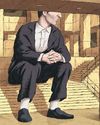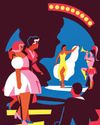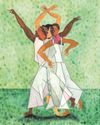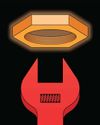
The Tramp was born in the wardrobe department of Keystone Studios, in Los Angeles. The year was 1914, and Charlie Chaplin was a twenty-four-year-old contract player. Keystone was known for its slapstick comedies, and pantomime was more Chaplin’s comic genre. At first, nobody seemed sure what to do with him. Then one day the head of the studio, Mack Sennett, sensed that a scene they were shooting needed some funny business. Chaplin happened to be standing nearby. Sennett ordered him to put on comedy makeup “anything will do.”
On his way to wardrobe, Chaplin decided that everything should be a contradiction: a coat and hat that were too small, pants and shoes that were too big. Since the character was not supposed to be young, he added the mustache— very small, so it wouldn’t hide his expression. He performed the scene; Sennett loved it; and the Tramp was launched on his brilliant career.
In the earliest Tramp movies, “Mabel’s Strange Predicament” (seventeen minutes long) and “Kid Auto Races at Venice” (about six minutes), the Tramp character is annoying and disruptive. He smokes and he drinks. (Chaplin had sometimes played a drunk on the vaudeville stage.) But the character was popular, and after Chaplin added the Pierrot element, the touch of poetry, the Tramp as we know him came into being.
This story is from the November 20, 2023 edition of The New Yorker.
Start your 7-day Magzter GOLD free trial to access thousands of curated premium stories, and 9,000+ magazines and newspapers.
Already a subscriber ? Sign In
This story is from the November 20, 2023 edition of The New Yorker.
Start your 7-day Magzter GOLD free trial to access thousands of curated premium stories, and 9,000+ magazines and newspapers.
Already a subscriber? Sign In

ART OF STONE
\"The Brutalist.\"

MOMMA MIA
Audra McDonald triumphs in \"Gypsy\" on Broadway.

INTERNATIONAL AFFAIRS
\"Black Doves,\" on Netflix.

NATURE STUDIES
Kyle Abraham's “Dear Lord, Make Me Beautiful.”

WHAT GOOD IS MORALITY?
Ask not just where it came from but what it does for us

THE SPOTIFY SYNDROME
What is the world's largest music-streaming platform really costing us?

THE LEPER - LEE CHANGDONG
. . . to survive, to hang on, waiting for the new world to dawn, what can you do but become a leper nobody in the world would deign to touch? - From \"Windy Evening,\" by Kim Seong-dong.

YOU WON'T GET FREE OF IT
Alice Munro's partner sexually abused her daughter. The harm ran through the work and the family.

TALK SENSE
How much sway does our language have over our thinking?

TO THE DETECTIVE INVESTIGATING MY MURDER
Dear Detective, I'm not dead, but a lot of people can't stand me. What I mean is that breathing is not an activity they want me to keep doing. What I mean is, they want to knock me off. My days are numbered.